Investigating the Impact of the AI-Supported 5E (AI-s5E) Instructional Model on Spatial Ability
Abstract
1. Introduction
- Do the AI-s5E instructional models show a significant difference in students’ Spatial Ability Test (SAT) scores?
- Do the AI-s5E instructional models show a significant difference in students’ Spatial Visualization Test (SVT) scores?
- Do the AI-s5E instructional models show a significant difference in students’ Spatial Relations Test (SRT) scores?
- Do the AI-s5E instructional models show a significant difference in students’ Spatial Orientation Test (SOT) scores?
1.1. Literature Review
1.1.1. AI in Education
1.1.2. Spatial Ability (SA)
2. Materials and Methods
2.1. Research Design
2.2. Study Group
2.3. Data Collection Tools
2.4. Instruction Process in Experiment and Control Groups
2.4.1. Experimental Group
- AI activities were carried out in groups in the classroom.
- AI tools and worksheets were used: laptops, tablets, colored pencils, and blackboards.
- Working in groups of three (students constantly interacting with each other).
- Students reinforced what they learned with AI tools.
- Students were mostly active and guided by the teacher.
Sample Activity Prepared Using AI Tools
2.4.2. Control Group
- Teaching was carried out in a traditional classroom environment with desks one after the other.
- Activities from the curriculum textbook were used: blackboards, notebooks, and colored pencils.
- Students were individual (students did not interact much with each other).
- Students usually listened to the teacher and answered the teacher’s questions.
2.5. Data Analysis
3. Results
3.1. Descriptive Statistics Results for Pre-Test and Post-Test Scores
3.2. Findings Related to SAT and Its Sub-Dimensions Post-Test Results of Experimental and Control Groups
3.3. Findings Related to ANCOVA for SAT and Its Sub-Dimensions
4. Discussion
5. Conclusions
Author Contributions
Funding
Institutional Review Board Statement
Informed Consent Statement
Data Availability Statement
Conflicts of Interest
References
- NCTM. Principles to Actions: Ensuring Mathematical Success for All; National Council of Teachers of Mathematics: Reston, VA, USA, 2014. [Google Scholar]
- Hall, W.; Pesenti, J. Growing the Artificial İntelligence İndustry in the UK. 2017. Available online: http://ftp.shujuju.cn/platform/file/2017-10-18/782c432045784854a04e458976aef0bf.pdf (accessed on 15 June 2024).
- Nabiyev, V.; Erumit, A.K. (Eds.) Yapay zekanın temelleri [Fundamentals of artificial intelligence]. In Eğitimde Yapay Zeka Kuramdan Uygulamaya [Artificial İntelligence in Education from Theory to Practice]; Pegem Publishing: Ankara, Turkey, 2022. [Google Scholar]
- Chen, X.; Xie, H.; Zou, D.; Hwang, G.J. Application and theory gaps during the rise of artificial ıntelligence in education. Comput. Educ. Artif. Intell. 2020, 1, 100002. [Google Scholar] [CrossRef]
- Hinojo-Lucena, F.J.; Aznar-Díaz, I.; Caceres-Reche, M.P.; Romero-Rodríguez, J.M. Artificial intelligence in higher education: A bibliometric study on its impact in the scientific literature. Educ. Sci. 2019, 9, 51. [Google Scholar] [CrossRef]
- Kabudi, T.; Pappas, I.; Olsen, D.H. AI-enabled adaptive learning systems: A systematic mapping of the literature. Comput. Educ. Artif. Intell. 2021, 2, 100017. [Google Scholar] [CrossRef]
- Zawacki-Richter, O.; Marín, V.I.; Bond, M.; Gouverneur, F. Systematic review of research on artificial intelligence applications in higher education—Where are the educators? Int. J. Educ. Technol. High. Educ. 2019, 16, 39. [Google Scholar] [CrossRef]
- Zhang, K.; Aslan, A.B. AI technologies for education: Recent research & future directions. Comput. Educ. Artif. Intell. 2021, 2, 100025. [Google Scholar] [CrossRef]
- Ee, J.H.; Huh, N. A study on the relationship between artificial intelligence and change in mathematics education. Commun. Math. Educ. 2018, 32, 23–36. [Google Scholar] [CrossRef]
- Görgüt, R.Ç. Artificial intelligence and mathematics education. In Education & Science 2023-IV; EFE Academy Publishing: Istanbul, Turkey, 2024. [Google Scholar]
- Ünlü, M.; Ertekin, E. A structural equation model for factors affecting eighth graders’ geometry achievement. Educ. Sci. Theory Pract. 2017, 17, 1815–1846. [Google Scholar] [CrossRef]
- Xie, F.; Zhang, L.; Chen, X.; Xin, Z. Is spatial ability related to mathematical ability: A meta-analysis. Educ. Psychol. Rev. 2020, 32, 113–155. [Google Scholar] [CrossRef]
- Dokumacı Sütçü, N. Zekâ Oyunlarının Ortaokul 7. Sınıf Öğrencilerinin Uzamsal Yeteneklerine ve Uzamsal Yetenek Öz-Değerlendirmelerine Etkisi [The Effects of Mind Games on Secondary School 7th Grade Students’ Spatial Abilities and Spatial Ability Self-Reports]. Ph.D. Dissertation, Dicle University, Diyarbakır, Turkey, 2017. [Google Scholar]
- Abdullah, A.H.; Abd Wahab, R.; Mokhtar, M.; Atan, N.A.; Abd Halim, N.D.; Surif, J.; Abd Rahman, S.N.S. Does sketchup make ımprove students’ visual-spatial skills? IEEE Access 2022, 10, 13936–13953. [Google Scholar] [CrossRef]
- Kayhan, E.B. Investigation of High School Students’ Spatial Ability. Ph.D. Dissertation, ODTÜ, Ankara, Turkey, 2005. [Google Scholar]
- Lohman, D.F. Spatial abilities as traits, processes, and knowledge. In Advances in the Psychology of Human İntelligence; Sternberg, R.J., Ed.; Lawrence Erlbaum Associates, Inc.: Mahwah, NJ, USA, 1988; Volume 4, pp. 181–248. [Google Scholar]
- Pittalis, M.; Christou, C. Types of reasoning in 3D geometry thinking and their relations with spatial ability. Educ. Stud. Math. 2010, 75, 191–212. [Google Scholar] [CrossRef]
- Ung, P.; Ngowtrakul, B.; Chotpradit, R.; Thavornwong, N. Spatial ability test for upper-elementary school student: Confirmatory factor and normative data analysis. J. Assoc. Res. 2016, 21, 48–57. [Google Scholar]
- Olkun, S.; Altun, A. İlköğretim öğrencilerinin bilgisayar deneyimleri ile uzamsal düşünme ve geometri başarıları arasındaki ilişki [The relationship between primary school students’ computer experiences and their spatial thinking and geometry achievements]. Turk. Online J. Educ. Technol. 2003, 2, 86–91. [Google Scholar] [CrossRef]
- Clements, D.H. Geometric and Spatial Thinking in Young Children; National Science Foundation: Alexandria, VA, USA, 1998. [Google Scholar]
- Hawes, Z.C.; Gilligan-Lee, K.A.; Mix, K.S. Effects of spatial training on mathematics performance: A meta-analysis. Dev. Psychol. 2022, 58, 112. [Google Scholar] [CrossRef] [PubMed]
- Cheng, Y.L.; Mix, K.S. Spatial training improves children’s mathematics ability. J. Cogn. Dev. 2014, 15, 2–11. [Google Scholar] [CrossRef]
- Estefania, G.; Thora, T.; Debra, M. Gender in Teacher-Student Interactions: Another Factor in Spatial Ability Development and STEM Affiliation. In German Conference on Spatial Cognition; Springer Nature: Cham, Switzerland, 2024; pp. 51–65. [Google Scholar]
- Toplu, D. A Descriptive Investigation of Turkish High School Students’ Spatial Visualization Ability. Master’s Thesis, Bilkent Universitesi, Ankara, Turkey, 2020. [Google Scholar]
- Erdenechimeg, S.; Danaa, G. Some Results and Evaluation of Training for the Development of Students’ Spatial Visualization. Embed. Selforganising Syst. 2023, 10, 82–88. [Google Scholar] [CrossRef]
- Dere, H.E.; Kalelioglu, F. The effects of using web-based 3D design environment on spatial visualisation and mental rotation abilities of secondary school students. Inform. Educ. 2020, 19, 399–424. [Google Scholar] [CrossRef]
- Dokumacı Sütçü, N. Ortaokul öğrencilerinin uzamsal görselleştirme becerilerinin incelenmesi [Investigating the spatial visualization skills of secondary school students]. In Proceedings of the Vth International Eurasian Educational Research Congress, Antalya, Turkey, 2–5 May 2018; pp. 197–199. [Google Scholar]
- Turgut, M.; Yılmaz, S. Investigation of 7th and 8th grade students’ spatial ability. Dicle Üniversitesi Ziya Gökalp Eğitim Fakültesi Derg. 2012, 19, 69–79. [Google Scholar] [CrossRef]
- İrioğlu, Z.; Ertekin, E. İlköğretim ikinci kademe öğrencilerinin zihinsel döndürme becerilerinin bazı değişkenler açısından incelenmesi [Investigation of mental rotation skills of primary school second grade students in terms of some variables]. J. Educ. Instr. Stud. World 2012, 2, 75–81. [Google Scholar]
- Demirkaya, C.; Masal, M. Geometrik-mekanik oyunlar temelli etkinliklerin ortaokul öğrencilerinin uzamsal düşünebilme becerilerine etkisi [The Effect of Geometric-Mechanic Games Based Activities on the Spatial Skills of Secondary School Students]. Sak. Univ. J. Educ. 2017, 7, 600–610. [Google Scholar]
- Newman, S.D.; Hansen, M.T.; Gutierrez, A. An fMRI study of the impact of block building and board games on spatial ability. Front. Psychol. 2016, 7, 12–78. [Google Scholar] [CrossRef]
- Güven, B.; Kösa, T. The effect of dynamic geometry software on student mathematics teachers’ spatial visualization skills. Turk. Online J. Educ. Technol.—TOJET 2008, 7, 100–107. [Google Scholar]
- Corradini, A. A study on whether digital games can effect spatial reasoning skills. In Handbook of Research on Improving Learning and Motivation through Educational Games: Multidisciplinary Approaches; IGI Global: Hershey, PA, USA, 2011; Volume 1, pp. 1086–1110. [Google Scholar]
- Guo, W.; Li, S.; Zhang, Z.; Chen, Z.; Chang, K.; Wang, S. A “magic world” for children: Design and development of a serious game to improve spatial ability. Comput. Animat. Virtual Worlds 2023, 34, e2181. [Google Scholar] [CrossRef]
- Lin, C.H.; Chen, C.M. Developing spatial visualization and mental rotation with a digital puzzle game at primary school level. Comput. Hum. Behav. 2016, 57, 23–30. [Google Scholar] [CrossRef]
- Martin-Dorta, N.; Sanchez-Berriel, I.; Bravo, M.; Hernandez, J.; Saorin, J.L.; Contero, M. Virtual blocks: A serious game for spatial ability improvement on mobile devices. Multimed. Tools Appl. 2014, 73, 1575–1595. [Google Scholar] [CrossRef]
- Yang, K.L.; Chen, C.Y. Effects of non-digital games integrated with digital games for advancing fifth graders’ spatial reasoning abilities. Educ. Inf. Technol. 2024, 29, 6341–6356. [Google Scholar] [CrossRef]
- Yıldız, B.; Tüzün, H. Üç-boyutlu sanal ortam ve somut materyal kullanımının uzamsal yeteneğe etkileri [Effects of using three-dimensional virtual environments and concrete manipulatives on spatial Ability]. Hacet. Üniversitesi Eğitim Fakültesi Derg. 2011, 41, 498–508. [Google Scholar] [CrossRef]
- Çam, E.; Kılıçer, K. The effect of virtual reality assisted robotics coding teaching on spatial visualization and coding skills. Eğitimde Kuram Uygul. 2022, 18, 68–84. [Google Scholar] [CrossRef]
- Julià, C.; Antolí, J.Ò. Spatial ability learning through educational robotics. Int. J. Technol. Des. Educ. 2016, 26, 185–203. [Google Scholar] [CrossRef]
- Julià, C.; Antolì, J.Ò. Enhancing spatial ability and mechanical reasoning through a STEM course. Int. J. Technol. Des. Educ. 2018, 28, 957–983. [Google Scholar] [CrossRef]
- Sisman, B.; Kucuk, S.; Yaman, Y. The effects of robotics training on children’s spatial ability and attitude toward STEM. Int. J. Soc. Robot. 2021, 13, 379–389. [Google Scholar] [CrossRef]
- Liu, Q.; Cameron, A. 3D Design Tasks on Interactive Whiteboards: Impacts of Synchronous Manipulation and Individual Spatial Ability. Ph.D. Dissertation, HEC Montréal, Montréal, QC, Canada, 2023. [Google Scholar]
- Fahmi, S.; Widayati, W.; Priwantoro, S.W. Android learning media development to ımprove spatial ability. Phenom. J. Pendidik. MIPA 2022, 12, 90–107. [Google Scholar] [CrossRef]
- Yunianto; Cahyono, A.N. Learning media development to ımprove student’s spatial mathematical ability with mobile phone using augmented reality. Unnes J. Math. Educ. 2021, 10, 182–193. [Google Scholar]
- Hwang, G.J.; Xie, H.; Wah, B.W.; Gašević, D. Vision, challenges, roles and research issues of artificial intelligence in education. Comput. Educ. Artif. Intell. 2020, 1, 100001. [Google Scholar] [CrossRef]
- Mohamed, M.Z.b.; Hidayat, R.; Suhaizi, N.N.b.; Sabri, N.b.M.; Mahmud, M.K.H.b.; Baharuddin, S.N.b. Artificial intelligence in mathematics education: A systematic literature review. Int. Electron. J. Math. Educ. 2022, 17, em0694. [Google Scholar] [CrossRef]
- Cope, B.; Kalantzis, M.; Searsmith, D. Artificial intelligence for education: Knowledge and its assessment in AI-enabled learning ecologies. Educ. Philos. Theory 2020, 53, 1229–1245. [Google Scholar] [CrossRef]
- Liu, S.; Guo, D.; Sun, J.; Yu, J.; Zhou, D. MapOnLearn: The use of maps in online learning systems for education sustainability. Sustainability 2020, 12, 7018. [Google Scholar] [CrossRef]
- Roll, I.; Wylie, R. Evolution and revolution in artificial intelligence in education. Int. J. Artif. Intell. Educ. 2016, 26, 582–599. [Google Scholar] [CrossRef]
- Majid, I.; Lakshmi, Y.V. Artificial intelligence in education. Artif. Intell. Educ. Indian J. Tech. Educ. 2022, 45, 11–16. [Google Scholar]
- Bozkurt, A.; Karadeniz, A.; Baneres, D.; Guerrero-Roldán, A.E.; Rodríguez, M.E. Artificial intelligence and reflections from educational landscape: A review of AI studies in half a century. Sustainability. 2021, 13, 800. [Google Scholar] [CrossRef]
- Hwang, G.J. Definition, framework and research issues of smart learning environments-a context-aware ubiquitous learning perspective. Smart Learn. Environ. 2014, 1, 4. [Google Scholar] [CrossRef]
- Motlagh, N.Y.; Khajavi, M.; Sharifi, A.; Ahmadi, M. The impact of artificial intelligence on the evolution of digital education: A comparative study of openAI text generation tools including ChatGPT, Bing Chat, Bard, and Ernie. arXiv 2023, arXiv:2309.02029. [Google Scholar]
- Voskoglou, M.G.; Salem, A.B.M. Benefits and limitations of the artificial with respect to the traditional learning of mathematics. Mathematics 2020, 8, 611. [Google Scholar] [CrossRef]
- Oueini, S. The Impact of Intelligent Tutoring Software on Geometry Students. Ph.D. Dissertation, University of South Carolina, Columbia, BC, USA, 2019. Available online: https://scholarcommons.sc.edu/etd/5187 (accessed on 1 June 2024).
- Duzhin, F.; Gustafsson, A. Machine learning-based app for self-evaluation of teacher-specific instructional style and tools. Educ. Sci. 2018, 8, 7–21. [Google Scholar] [CrossRef]
- Hwang, G.J.; Tu, Y.F. Roles and research trends of artificial intelligence in mathematics education: A bibliometric mapping analysis and systematic review. Mathematics 2021, 9, 584. [Google Scholar] [CrossRef]
- Korkmaz Guler, N.; Dertli, Z.G.; Boran, E.; Yildiz, B. An artificial intelligence application in mathematics education: Evaluating ChatGPT’s academic achievement in a mathematics exam. Pedagog. Res. 2024, 9, em0188. [Google Scholar] [CrossRef] [PubMed]
- D’Oliveira, T.C. Dynamic spatial ability: An exploratory analysis and a confirmatory study. Int. J. Aviat. Psychol. 2004, 14, 19–38. [Google Scholar] [CrossRef]
- McGrew, K.S. CHC theory and the human cognitive abilities project: Standing on the shoulders of the giants of psychometric intelligence research. Intelligence 2009, 37, 1–10. [Google Scholar] [CrossRef]
- Çepni, S. Araştırma ve Proje Çalışmalarına Giriş [Introduction to Research and Project Work]; Celepler Printing: Trabzon, Turkey, 2011. [Google Scholar]
- Trowbridge, L.W.; Bybee, R.W. Becoming a Secondary School Science Teacher; Merrill Publishing Company: Merrill, WI, USA, 1990. [Google Scholar]
- Büyüköztürk, Ş. Bilimsel Araştırma Yöntemleri [Scientific Research Methods], 22nd ed.; Pegem Akademi Publishing: Kızılay, Turkey, 2016. [Google Scholar]
- Tabachnick, B.G.; Fidell, L.S. Using Multivariate Statistics, 6th ed.; Allyn and Bacon: Boston, MA, USA, 2013. [Google Scholar]
- Cohen, J. Statistical Power Analysis for the Behavioral Sciences, 2nd ed.; Erlbaum: Hillsdale, NJ, USA, 1988. [Google Scholar]
- Sutton, K.; Heathcote, A.; Bore, M. Implementing a Web-based measurement of 3-D understanding. In Proceedings of the 19th Conference of the Computer-Human Interaction Special Interest Group (CHISIG) of Australia on Computer-Human İnteraction: Citizens Online; Considerations for Today and the Future, Canberra, Australia, 23–25 November 2005; CHISIG: Narrabundah, Australia, 2005; pp. 1–4. [Google Scholar]
- Ben-Chaim, D.; Lappan, G.; Houang, R.T. Development and analysis of a spatial visualization test for middle school boys and girls. Percept. Mot. Ski. 1986, 63, 659–669. [Google Scholar] [CrossRef] [PubMed]
- Battista, M.T.; Clements, D. Students’ understanding of three-dimensional rectangular arrays of cubes. J. Res. Math. Educ. 1996, 27, 258–292. [Google Scholar] [CrossRef]
- Contero, M.; Naya, F.; Company, P.; Saorin, J.L.; Conesa, J. Improving visualization skills in engineering education. IEEE Comput. Graph. Appl. 2005, 25, 24–31. [Google Scholar] [CrossRef]
- Baki, A.; Kosa, T.; Güven, B. A comparative study of effects of using dynamic geometry software and physical manipulatives on spatial visualization skills of pre-service mathematics teachers. Br. J. Educ. Technol. 2011, 42, 291–310. [Google Scholar] [CrossRef]
- Coxon, S.V. The malleability of spatial ability under treatment of a FIRST LEGO League-based robotics simulation. J. Educ. Gift. 2012, 35, 291–316. [Google Scholar] [CrossRef]
- Verner, I.M. Robot manipulations: A synergy of visualization, computation and action for spatial instruction. Int. J. Comput. Math. Learn. 2004, 9, 213–234. [Google Scholar] [CrossRef]
- Sutton, K.; Williams, A. Spatial Cognition and İts İmplications for Design; In Proceedings of the International Association of Societies of Design Research—IASDR07, Hong Kong, 12–15 November 2007.
- NCTM. Principles and Standards for School Mathematics; NCTM: Reston, VA, USA, 2000. [Google Scholar]
- Jirout, J.J.; Newcombe, N.S. Building blocks for developing spatial skills: Evidence from a large, representative U.S. sample. Psychol. Sci. 2015, 26, 302–310. [Google Scholar] [CrossRef] [PubMed]
- Sorby, S.A. Educational research in developing 3-D spatial skills for engineering students. Int. J. Sci. Educ. 2009, 31, 459–480. [Google Scholar] [CrossRef]
- Gilligan, K.A.; Flouri, E.; Farran, E.K. The contribution of spatial ability to mathematics achievement in middle childhood. J. Exp. Child Psychol. 2017, 163, 107–125. [Google Scholar] [CrossRef] [PubMed]
- Wai, J.; Lubinski, D.; Benbow, C.P. Spatial ability for STEM domains: Aligning over 50 years of cumulative psychological knowledge solidifies its importance. J. Educ. Psychol. 2009, 101, 817–835. [Google Scholar] [CrossRef]
- González-Calero, J.A.; Cózar, R.; Villena, R.; Merino, J.M. The development of mental rotation abilities through robotics-based instruction: An experience mediated by gender. Br. J. Educ. Technol. 2019, 50, 3198–3213. [Google Scholar] [CrossRef]
- Harden, S.M.; Allen, K.C.; Chau, C.N.; Parks, S.L.; Zanko, A.L. Experiential learning in graduate education: Development, delivery, and analysis of an evidence-based intervention. Creat. Educ. 2012, 3, 649–657. [Google Scholar] [CrossRef][Green Version]
- Hegarty, M.; Crookes, R.D.; Dara-Abrams, D.; Shipley, T.F. Do all science disciplines rely on spatial abilities? Preliminary evidence from self-report questionnaires. In International Conference on Spatial Cognition; Springer: Berlin/Heidelberg, Germany, 2010; pp. 85–94. [Google Scholar]
- Gao, S. Innovative teaching of integration of artificial intelligence and university mathematics in big data environment. IOP Conf. Ser. Mater. Sci. Eng. 2020, 750, 012137. [Google Scholar] [CrossRef]
- Yeşilbaş Özenç, Y.; Başaran, R. Yaşam boyu öğrenme ve yapay zekâ [Lifelong learning and artificial intelligence]. Sinop Üniversitesi Eğitim Fakültesi Derg. 2024, 1, 101–125. [Google Scholar]
- Papert, S. Mindstorms—Children, Computers and Powerful Ideas; Basic Books, Inc.: New York, NY, USA, 1980. [Google Scholar]
- Francom, G.M.; Lee, S.J.; Pinkney, H. Technologies, challenges and needs of k-12 teachers in the transition to distance learning during the COVID-19 pandemic. TechTrends 2021, 65, 589–601. [Google Scholar] [CrossRef] [PubMed]
- Boakes, N.J. Origami instruction in the middle school mathematics classroom: Its impact on spatial visualization and geometry knowledge of students. RMLE Online (Res. Middle Level Educ.) 2019, 32, 1–12. [Google Scholar] [CrossRef]
- Hegarty, M.; Waller, D. A dissociation between mental rotation and perspective-taking spatial abilities. Intelligence 2004, 32, 175–191. [Google Scholar] [CrossRef]
- Barker, B.; Ansorge, J. Robotics as means to increase achievement scores in an informal learning environment. J. Res. Technol. Educ. 2007, 39, 229–243. [Google Scholar] [CrossRef]
- Uttal, D.H.; Miller, D.I.; Newcombe, N.S. Exploring and enhancing spatial thinking: Links to achievement in science, technology, engineering, and mathematics? Curr. Dir. Psychol. Sci. 2013, 22, 367–373. [Google Scholar] [CrossRef]
- McGee, M.G. Human spatial abilities: Psychometric studies and environmental, genetic, hormonal and neurological influences. Psychol. Bull. 1979, 86, 889–918. [Google Scholar] [CrossRef]
- Terzopoulos, G.; Satratzemi, M. Voice assistants and smart speakers in everyday life and in education. Inform. Educ. 2020, 19, 473–490. [Google Scholar] [CrossRef]
- Alkhatlan, A.; Kalita, J. Intelligent tutoring systems: A comprehensive historical survey with recent developments. Int. J. Comput. Appl. 2019, 181, 1–20. [Google Scholar] [CrossRef]
- Ouyang, F.; Jiao, P. Artificial intelligence in education: The three paradigms. Comput. Educ. Artif. Intell. 2021, 2, 100020. [Google Scholar] [CrossRef]
- Rahayu, S.T. Analyzing of using educational technology to ımprove the quality and equity of learning outcomes at politeknik maritim negeri. J. Iqra’ Kaji. Ilmu Pendidika 2023, 8, 100–116. [Google Scholar] [CrossRef]
- Zhang, L.; Basham, J.D.; Yang, S. Understanding the implementation of personalized learning: A research synthesis. Educ. Res. Rev. 2020, 31, 100339. [Google Scholar] [CrossRef]
- Ledesma, E.F.R.; García, J.J.G. Selection of mathematical problems in accordance with student’s learning style. Int. J. Adv. Comput. Sci. Appl. 2017, 8, 101–105. [Google Scholar] [CrossRef]
- Berland, M.; Davis, D.; Smith, C.P. AMOEBA: Designing for collaboration in computer science classrooms through live learning analytics. Int. J. Comput.-Support. Collab. Learn. 2015, 10, 425–447. [Google Scholar] [CrossRef]
- Liu, F.; Shi, Y.; Liu, Y. Intelligence quotient and intelligence grade of artificial intelligence. Ann. Data Sci. 2017, 4, 179–191. [Google Scholar] [CrossRef]
- Hwang, D.; Jung, J.J.; Nguyen, N.T. Computational Collective Intelligence—Technologies and Applications. In Proceedings of the 6th International Conference, ICCCI 2014, Seoul, Republic of Korea, 24–26 September 2014. [Google Scholar]
- Bozkurt, A.; Sharma, R.C. Challenging the status quo and exploring the new boundaries in the age of algorithms: Reimagining the role of generative AI in distance education and online learning. Asian J. Distance Educ. 2023, 18, i–viii. [Google Scholar] [CrossRef]
- Bozkurt, A.; Xiao, J.; Lambert, S.; Pazurek, A.; Crompton, H.; Koseoglu, S.; Farrow, R.; Bond, M.; Nerantzi, C.; Honeychurch, S.; et al. Speculative futures on ChatGPT and generative artificial intelligence (AI): A collective reflection from the educational landscape. Asian J. Distance Educ. 2023, 18, 53–130. [Google Scholar] [CrossRef]
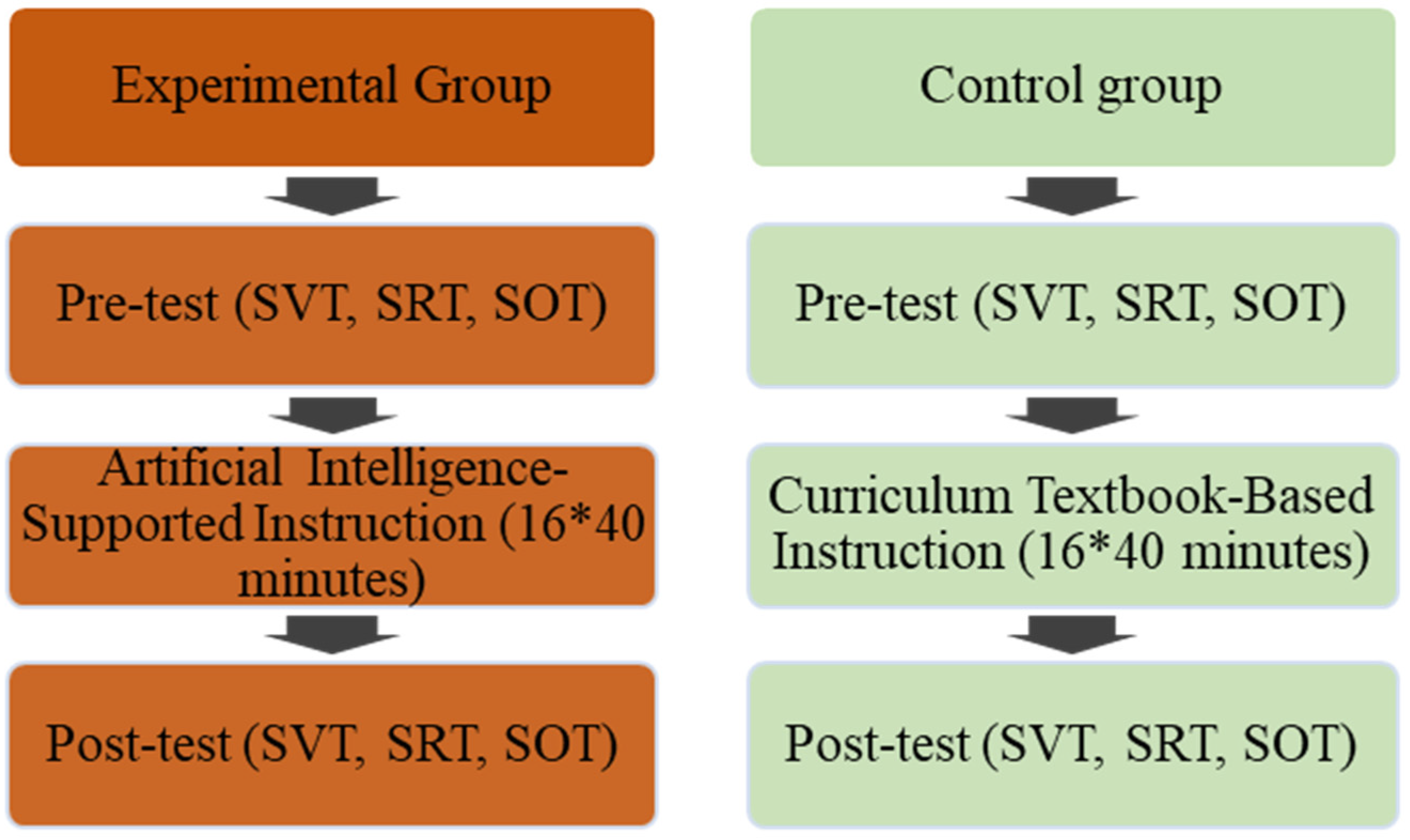

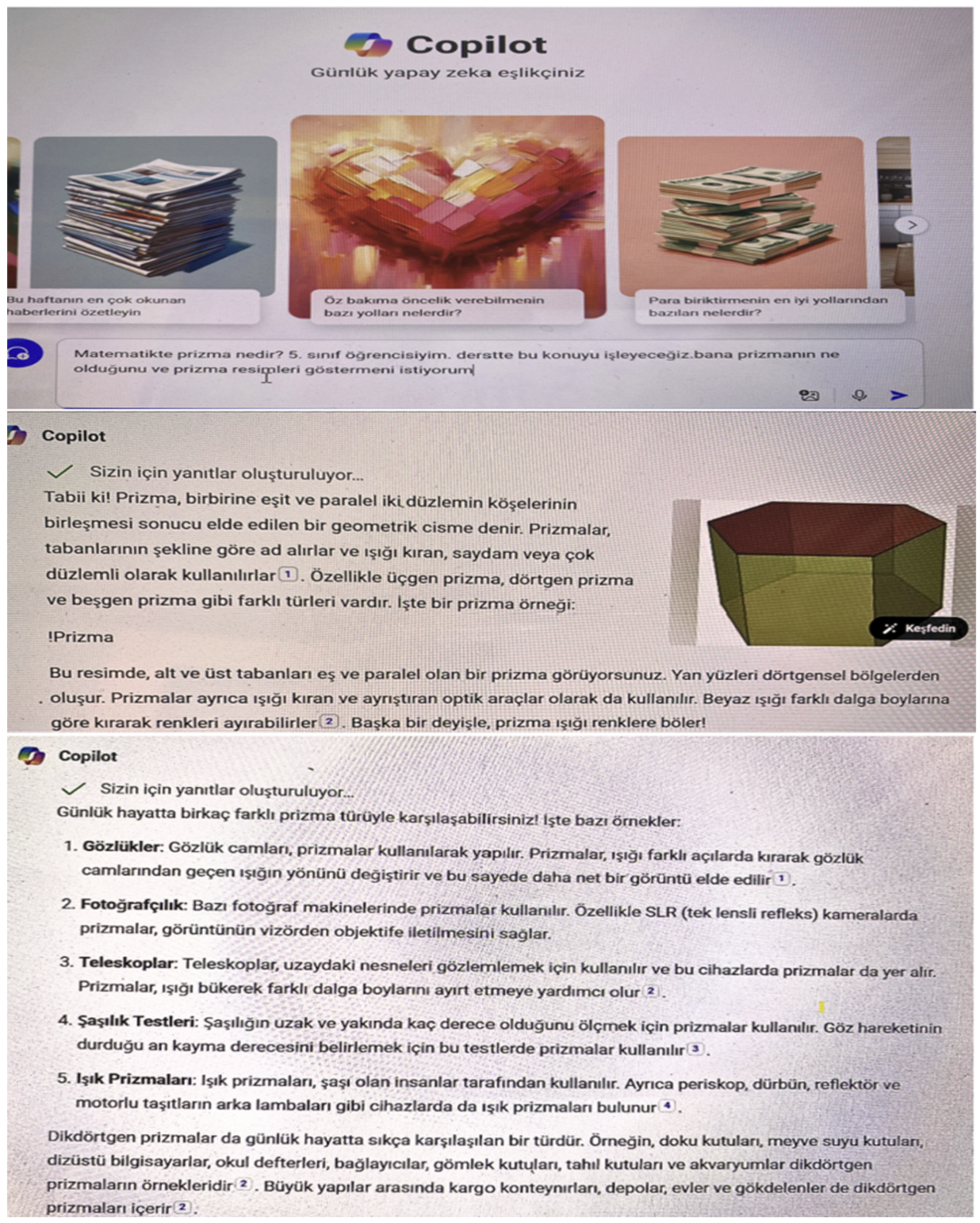
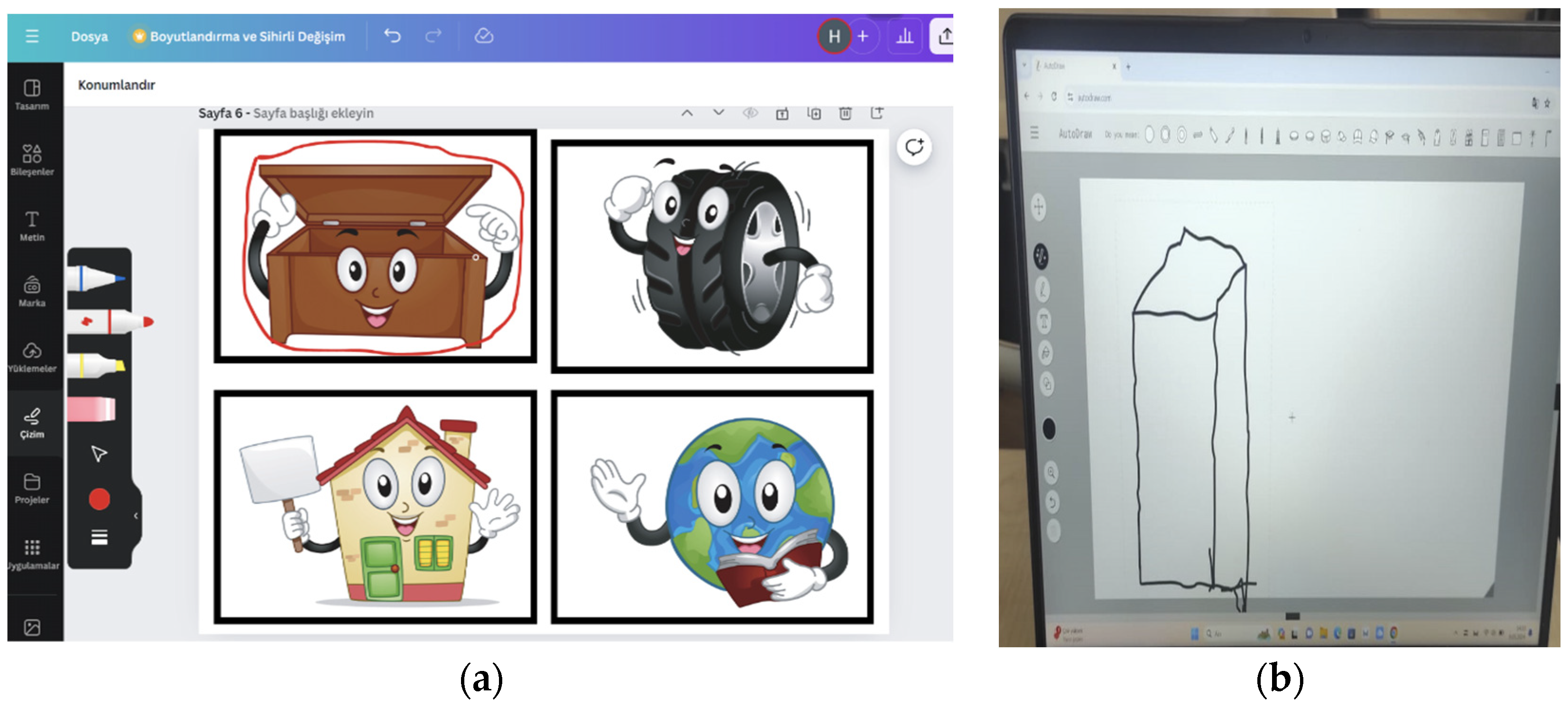
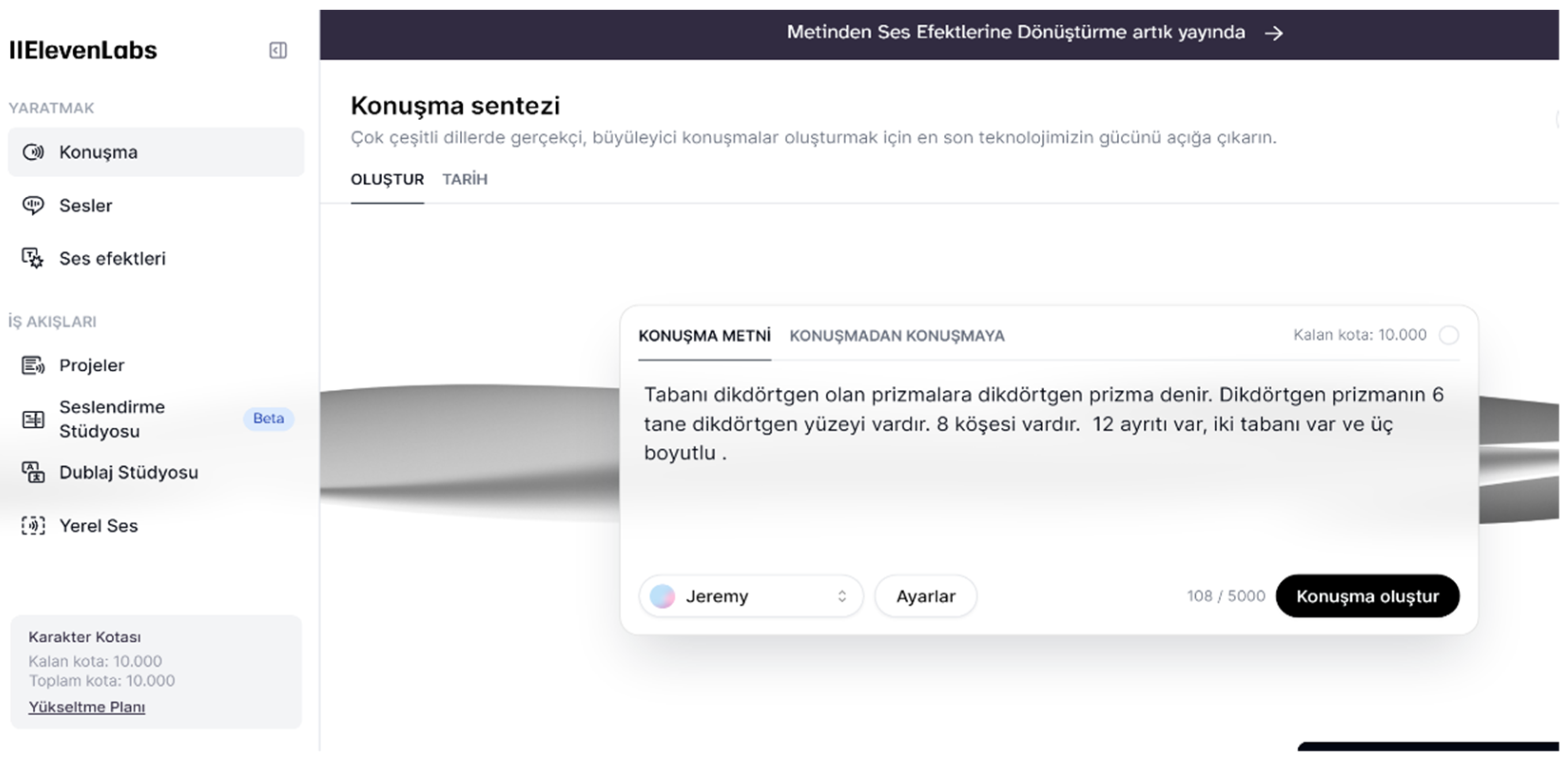
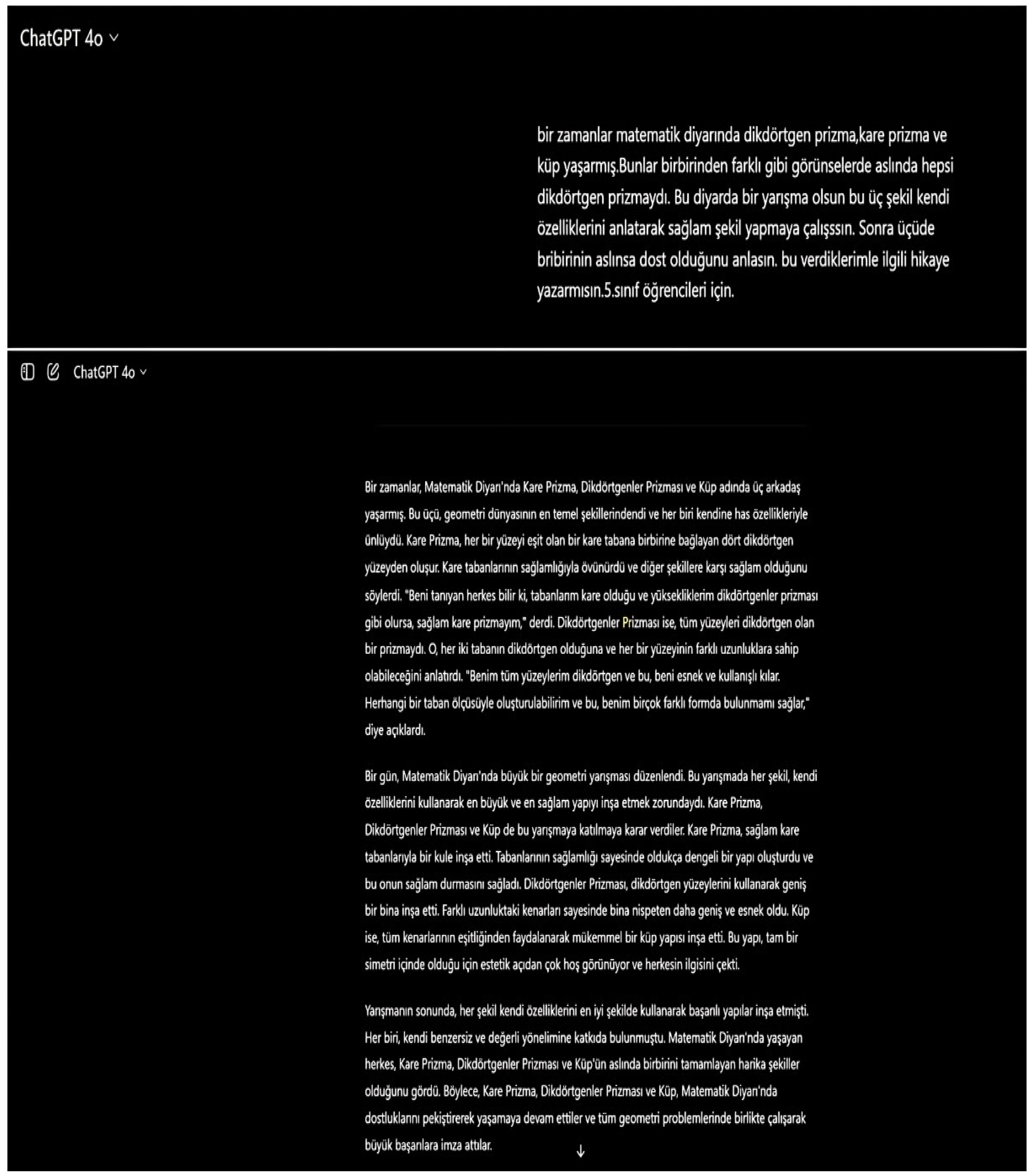
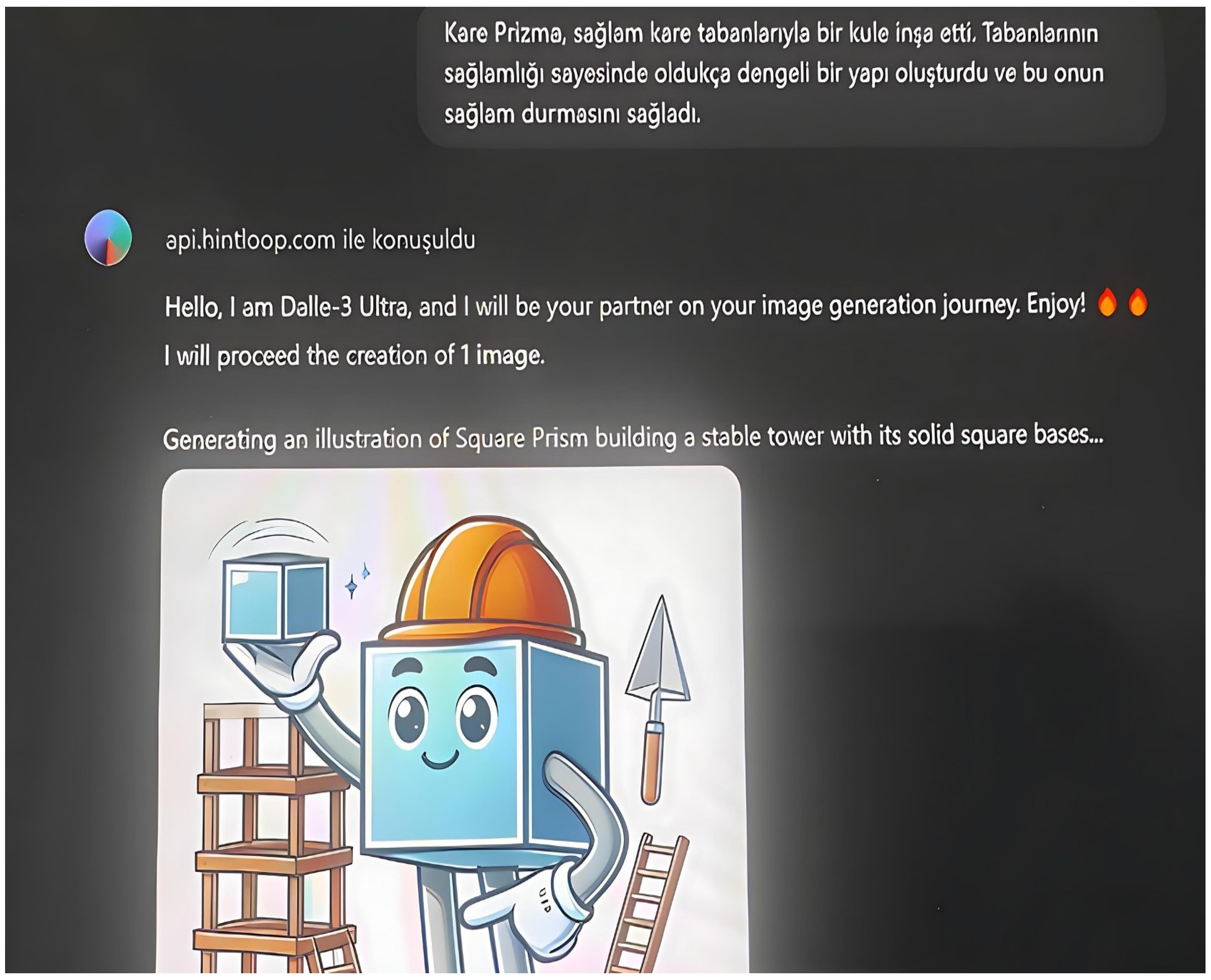

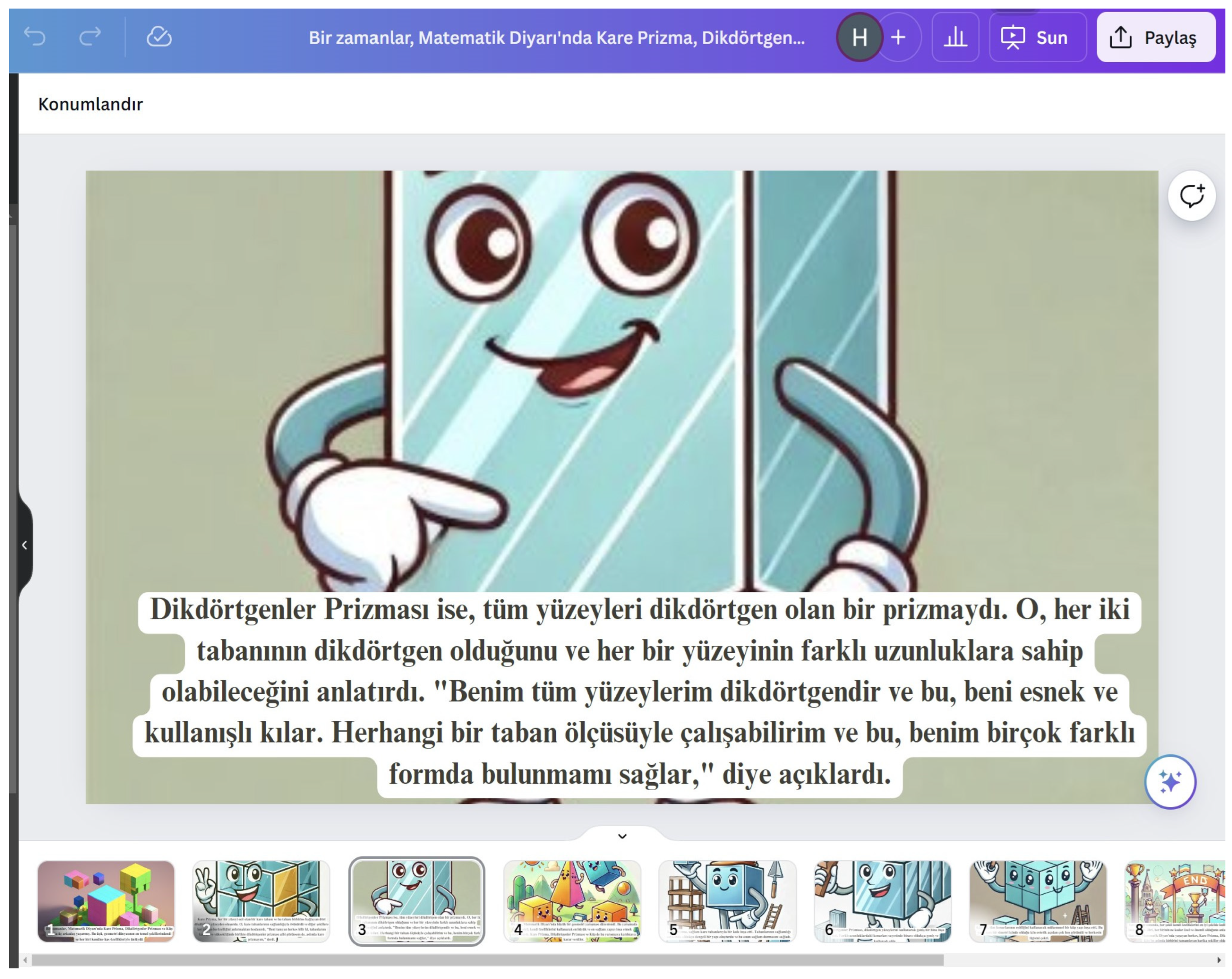
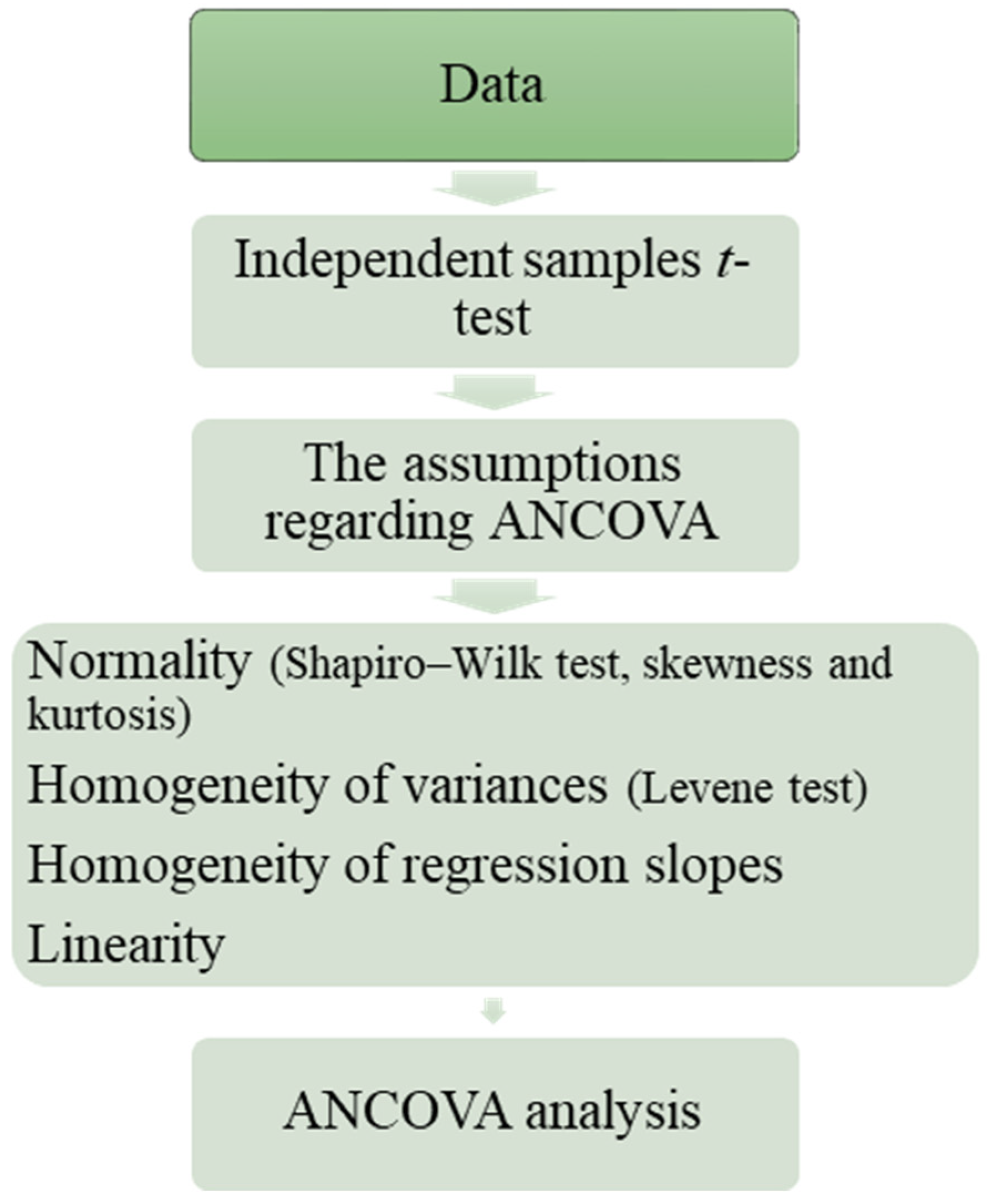
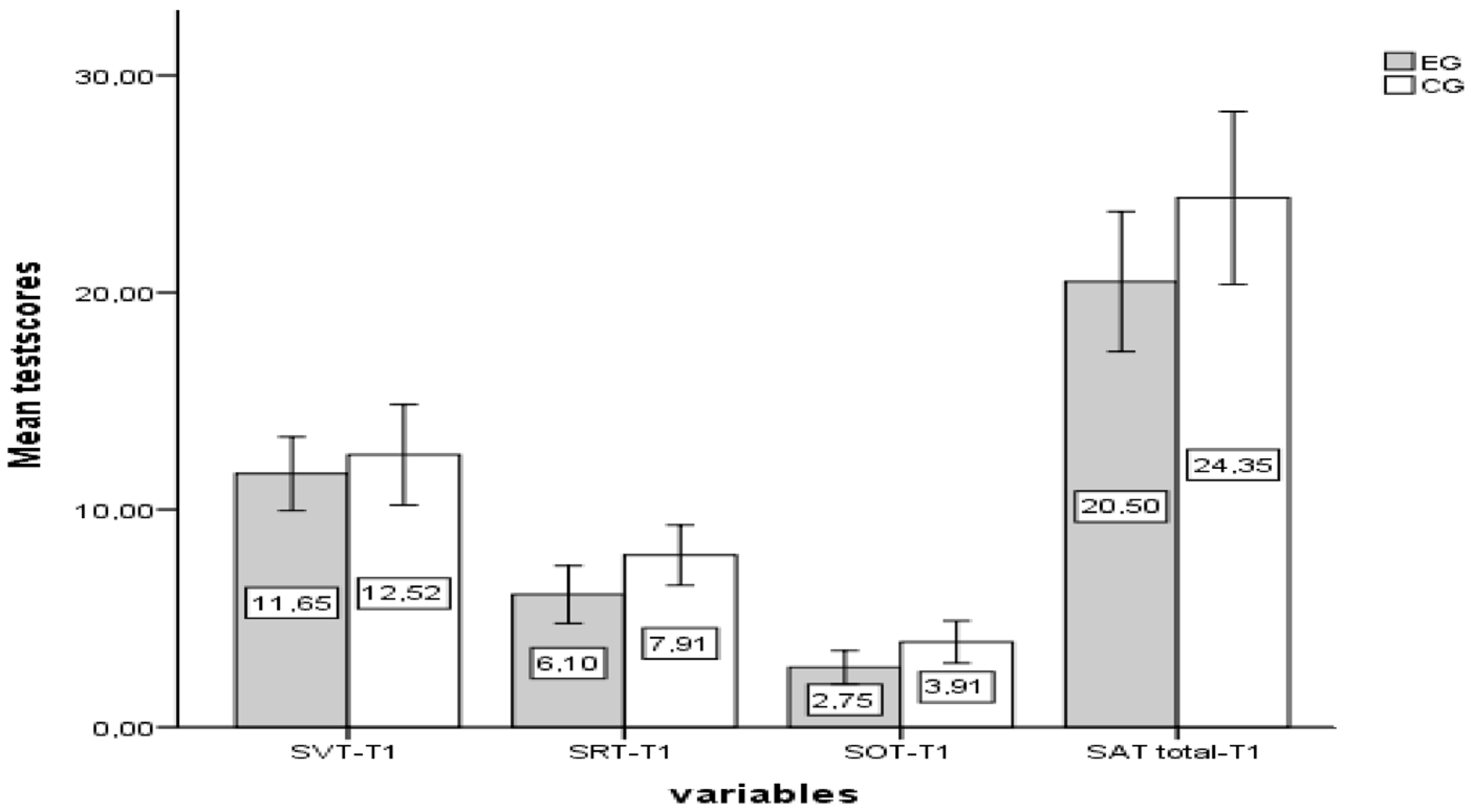
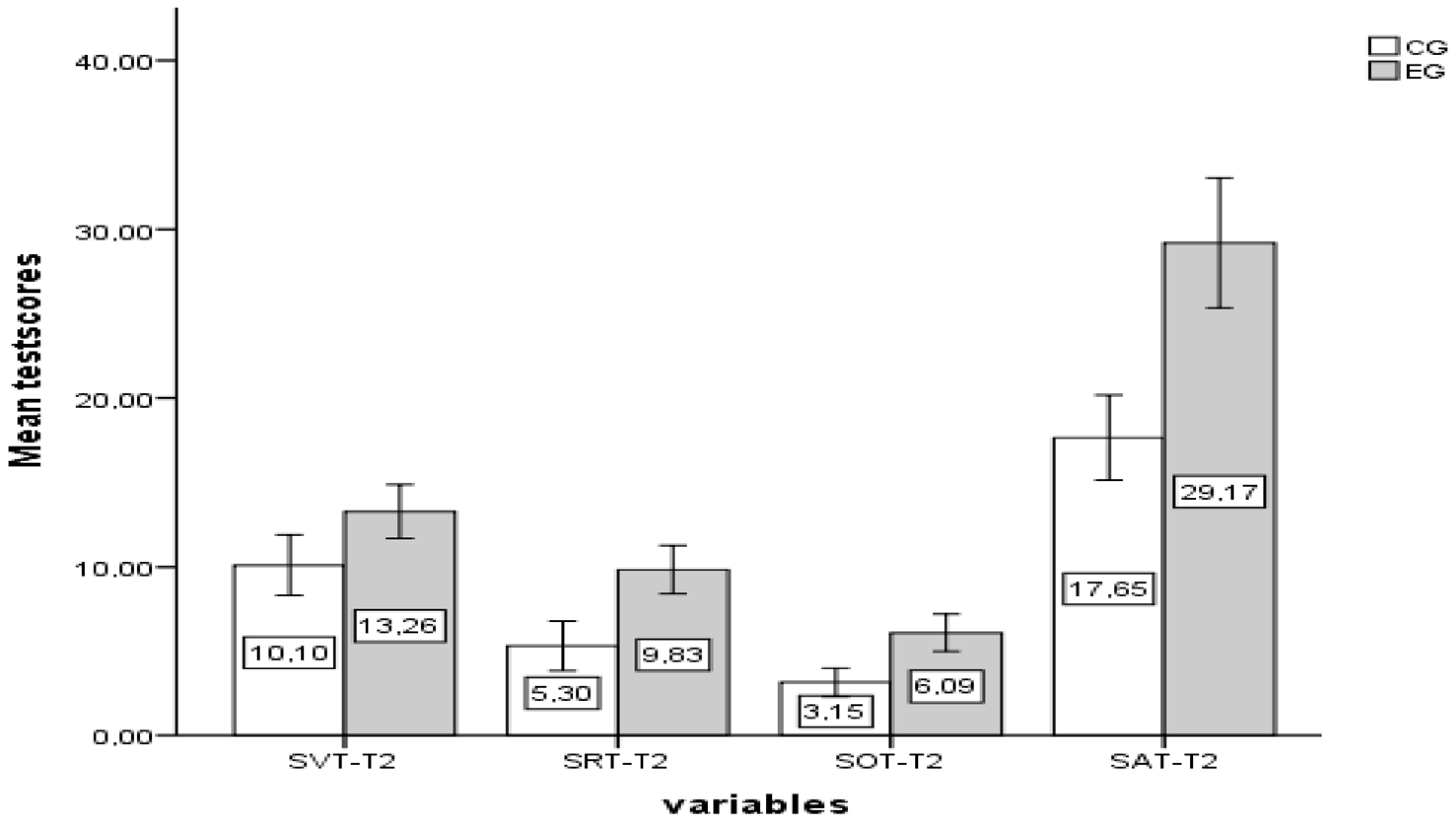
| Experimental Group | Control Group | HVT | |||||||||||||||
|---|---|---|---|---|---|---|---|---|---|---|---|---|---|---|---|---|---|
| N | M (SD) | Min | Max | Skew. | Kurto. | Shapiro–Wilk Tests (p) | N | M (SD) | Min | Max | Skew. | Kurto. | Shapiro–Wilk Tests (p) | Levene Statistic (p) | |||
| Pre-test | SAT | SVT | 23 | 12.52 (5.35) | 0 | 21 | −0.30 | −0.31 | 0.983 (p = 0.954) | 20 | 11.65 (3.63) | 7 | 18 | 0.27 | −1.08 | 0.933 (p = 0.180) | 0.183 (p = 0.671) |
| SRT | 23 | 7.91 (3.20) | 2 | 14 | −0.18 | −0.590 | 0.954 (p = 0.357) | 20 | 6.10 (2.82) | 1 | 12 | 0.13 | 0.07 | 0.964 (p = 0.634) | 0.876 (p = 0.355) | ||
| SOT | 23 | 3.91 (2.23) | 0 | 9 | 0.60 | 0.24 | 0.945 (p = 0.233) | 20 | 2.75 (1.65) | 0 | 6 | 0.44 | −0.77 | 0.910 (p = 0.063) | 0.485 (p = 0.490) | ||
| SAT Total | 23 | 24.35 (9.20) | 5 | 38 | −0.18 | −0.88 | 0.952 (p = 0.329) | 20 | 20.50 (6.89) | 10 | 33 | 0.41 | −0.90 | 0.943 (p = 0.270) | 2.236 (p = 0.143) | ||
| Post-test | SAT | SVT | 23 | 13.26 (3.70) | 8 | 21 | 0.05 | 0.38 | 0.983 (p = 0.954) | 20 | 10.10 (3.83) | 5 | 19 | 0.79 | 0.07 | 0.933 (p = 0.180) | 0.183 (p = 0.671) |
| SRT | 23 | 9.83 (3.29) | 4 | 15 | 0.04 | −0.69 | 0.945 (p = 0.228) | 20 | 5.30 (3.16) | 1 | 13 | 1.01 | 0.69 | 0.911 (p = 0.068) | 0.279 (p = 0.600) | ||
| SOT | 23 | 6.13 (2.49) | 2 | 10 | −0.10 | −0.80 | 0.914 (p = 0.051) | 20 | 3.15 (1.78) | 1 | 6 | 0.42 | −1.20 | 0.883 (p = 0.020) | 1.826 (p = 0.184) | ||
| SAT Total | 23 | 29.17 (8.89) | 11 | 45 | 0.05 | −0.44 | 0.977 (p = 0.858) | 20 | 17.65 (5.38) | 9 | 26 | 0.14 | −0.82 | 0.940 (p = 0.239) | 3.964 (p = 0.053) | ||
| Reception of Homogenous Regression Slope | Correlation Pre-Test and Post-Test | |||||
|---|---|---|---|---|---|---|
| Intervention | Variable | F | p | Variable | r | p |
| Al-s5E instructional model | SVT*Group | 0.635 | 0.430 | SVT | 0.649 | 0.000 |
| SRT*Group | 0.319 | 0.576 | SRT | 0.632 | 0.000 | |
| SOT*Group | 0.029 | 0.865 | SOT | 0.637 | 0.000 | |
| SAT Total*Group | 1.895 | 0.177 | SAT | 0.726 | 0.000 | |
| Variable | Group | M | SD | Adjusted Mean | SE | F | Partial eta Squared (η2) |
|---|---|---|---|---|---|---|---|
| SVT | Experiment 1 | 13.26 | 3.70 | 13.03 | 0.59 | 10.15 * | 0.202 |
| Control | 10.10 | 3.83 | 10.36 | 0.62 | |||
| SRT | Experiment 1 | 9.83 | 3.29 | 9.29 | 0.56 | 16.06 * | 0.286 |
| Control | 5.30 | 3.16 | 5.91 | 0.60 | |||
| SOT | Experiment 1 | 6.13 | 2.49 | 5.72 | 0.38 | 13.90 * | 0.258 |
| Control | 3.15 | 1.78 | 3.56 | 0.41 | |||
| SAT total | Experiment 1 | 29.17 | 8.89 | 27.93 | 1.03 | 32.94 * | 0.452 |
| Control | 17.65 | 5.38 | 19.07 | 1.11 |
Disclaimer/Publisher’s Note: The statements, opinions and data contained in all publications are solely those of the individual author(s) and contributor(s) and not of MDPI and/or the editor(s). MDPI and/or the editor(s) disclaim responsibility for any injury to people or property resulting from any ideas, methods, instructions or products referred to in the content. |
© 2024 by the authors. Licensee MDPI, Basel, Switzerland. This article is an open access article distributed under the terms and conditions of the Creative Commons Attribution (CC BY) license (https://creativecommons.org/licenses/by/4.0/).
Share and Cite
Gürefe, N.; Sarpkaya Aktaş, G.; Öksüz, H. Investigating the Impact of the AI-Supported 5E (AI-s5E) Instructional Model on Spatial Ability. Behav. Sci. 2024, 14, 682. https://doi.org/10.3390/bs14080682
Gürefe N, Sarpkaya Aktaş G, Öksüz H. Investigating the Impact of the AI-Supported 5E (AI-s5E) Instructional Model on Spatial Ability. Behavioral Sciences. 2024; 14(8):682. https://doi.org/10.3390/bs14080682
Chicago/Turabian StyleGürefe, Nejla, Gülfem Sarpkaya Aktaş, and Hava Öksüz. 2024. "Investigating the Impact of the AI-Supported 5E (AI-s5E) Instructional Model on Spatial Ability" Behavioral Sciences 14, no. 8: 682. https://doi.org/10.3390/bs14080682
APA StyleGürefe, N., Sarpkaya Aktaş, G., & Öksüz, H. (2024). Investigating the Impact of the AI-Supported 5E (AI-s5E) Instructional Model on Spatial Ability. Behavioral Sciences, 14(8), 682. https://doi.org/10.3390/bs14080682






